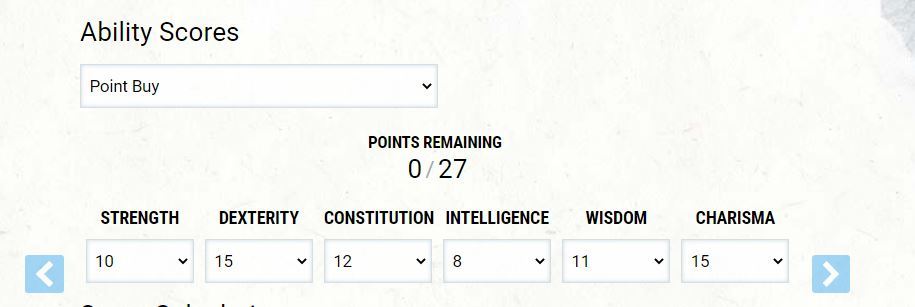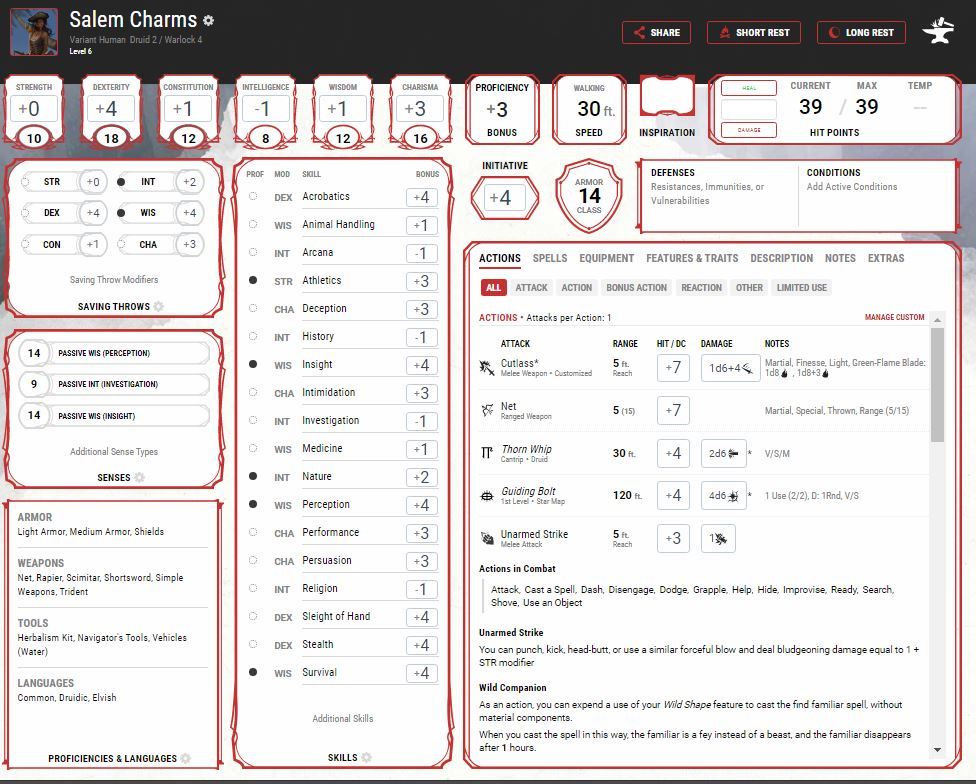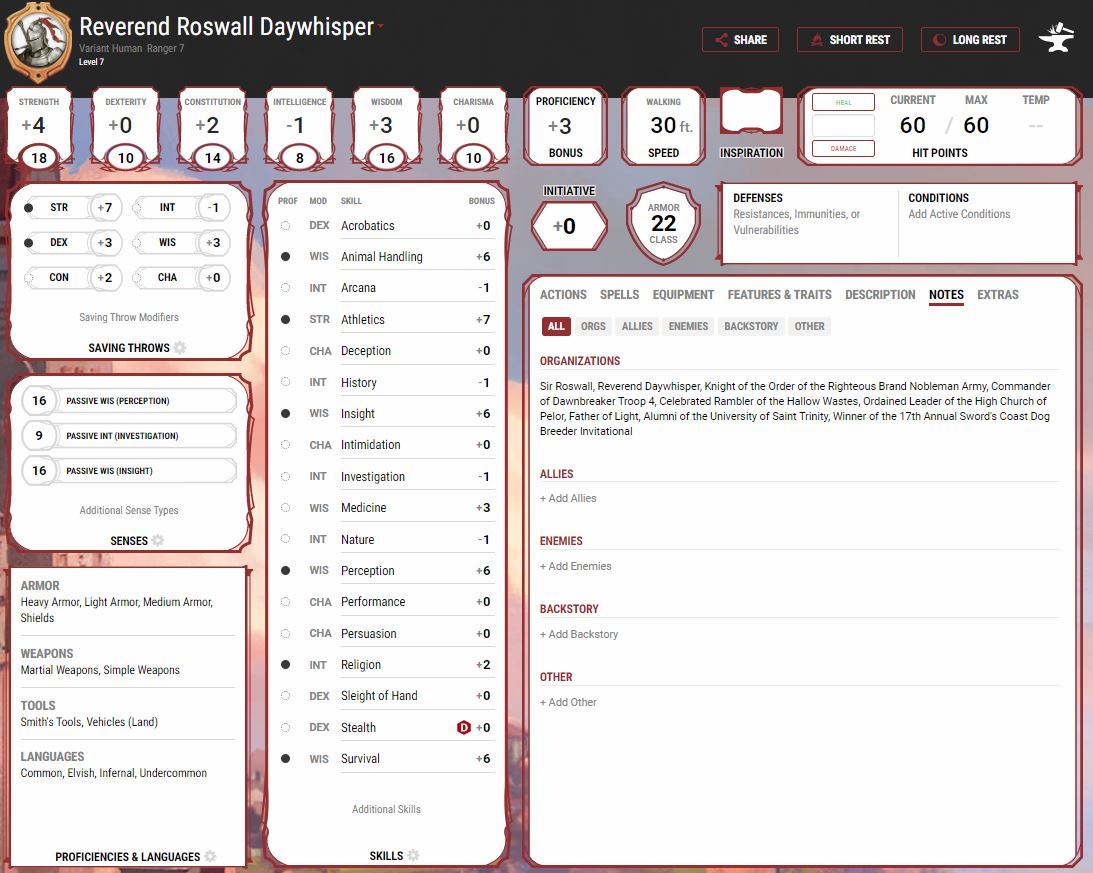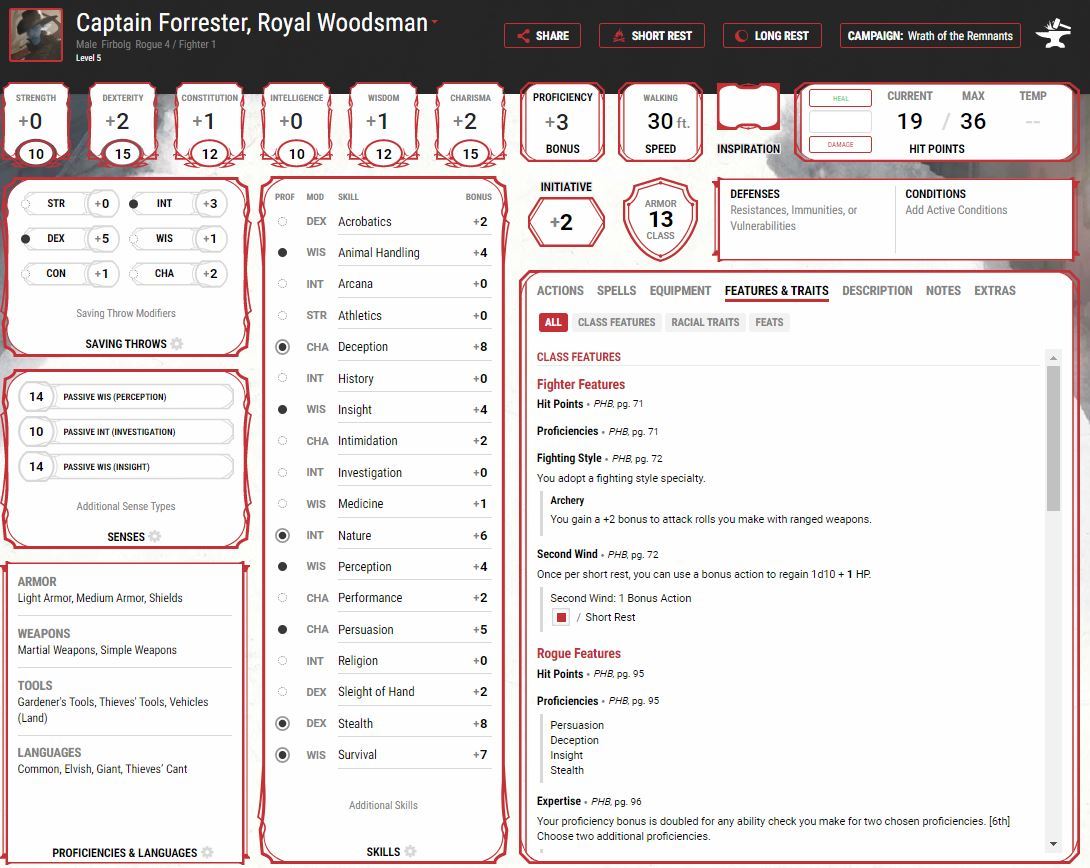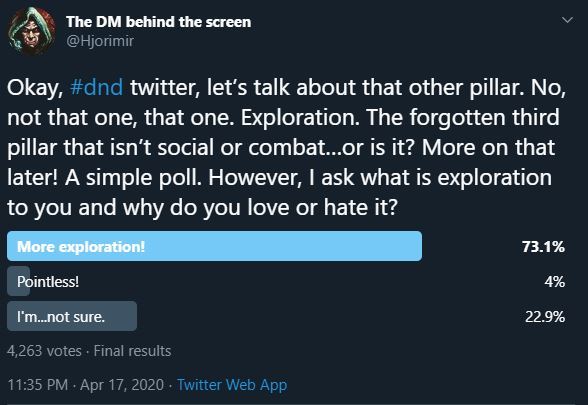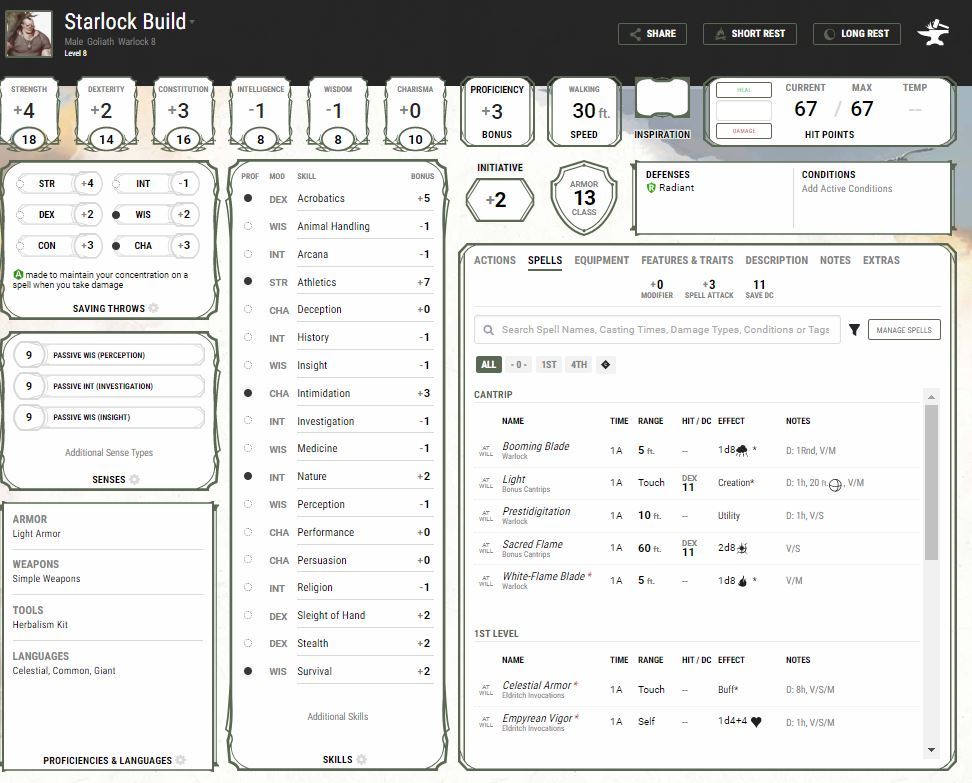 As part of a New Year Resolution to try to make (and hopefully play) character types that are outside my comfort zone, I've set about making a Druid/Warlock. It's a weird combo to put together. Frankly, at times, I wondered why I was doing this at all. But then I found some cool new feautres in Tasha's that I haven't seen at the table yet, and I think would be fun. For the audio walk-through of this, check out the episode.
As part of a New Year Resolution to try to make (and hopefully play) character types that are outside my comfort zone, I've set about making a Druid/Warlock. It's a weird combo to put together. Frankly, at times, I wondered why I was doing this at all. But then I found some cool new feautres in Tasha's that I haven't seen at the table yet, and I think would be fun. For the audio walk-through of this, check out the episode.
Meet the Droo-lock
So, who is this character. Her name is Salem Charms (link to character sheet). She grew up in a bustling fishing town: her father a fisherman with a small boat, her mother running a fish & chips shop that serves up what her father has caught. She never liked her father's little boat; she envied the big ships that would frequent the harbour, dreaming of where they might be off to next. And she definitely didn't like the fish & chip shop -- she disliked how greasy she smelled at the end of the day. Hence, she never gained any proficiency with cook's tools. But she gained a love of the sea, and a passion for adventure. I based her on a picture by BobKehl
After leaving home and developing her adventuring skill, she gained her "druid" powers, which have almost nothing to do with taking a beast form. It's something she has only done a couple of times before, and only when drunk. It's not something she enjoys doing. But with the new Cricle of the Stars subclass, there are plenty of other cool things to do with her Wild Shape slots, in particular: Starry Form.
No Beast Forms, Thanks
Starry Form lets her transform the sailor tattoo on her shoulder into a massive tattoo that cover much of her body and glows. The new tattoo takes then takes the form of either the Archer, the Chalice or the Dragon, depending how she wants to expend that slot.
The other optional class feature which I've enabled for her is the ability to use the Wild Form slot to summon a familiar, which for her is a parrot. Yes, she calls him Polly. Bird familiars are quite usefull for recon , and she'll make good use of him as such. However, he's limited to only 1 hour of use, so he needs to be used wisely -- and then given a cracker as a reward.
It's worth noting also that I made her a variant human so that I could use the Weapon Master feat to give her proficiency with some nautical gear (and a small bump to Dexterity). I don't know if this is the best min/max idea ever, but I like the flavour that comes with her knowing how to use a net and a trident. She also picked up rapier and shortsword, so she can pick up nearly any wepaon you would find laying around a pirate ship and weild it well.
For her Star Map, I gave her a compass, much like that of Jack Sparrow's from the Pirates of the Carribean. It allows her to cast Guidance at will, and shoot a couple of guiding Bolts (although not so well as I nerfed her Wisdom a bit).
Here's the point buy I went for to develop her stat block:
Tentacles!
Which brings me to the challenge of a build like this, picking up the second spellcasting ability. Which for her is going to be Warlock, which requires a lot more in Charisma. I decided that this would be her primary offensive spell casting ability. And it would have a bit of a tentacle theme.
So spellcasting with two classes is always a bit tricky, but fortunately Warlock makes it easier by just providing a couple more slots at an ever increasing level that you can cast any of your spells through. But if they are Druid spells, they still use the Wisdom spell attack bonus, so I won't use it Druid spells to attack that much.
She's a Dex fighter, so I took Green-flame blade to boost her sword work. I took Mage Hand, but want to flavor it so that it's a long spectral tentacle that reaches out from her to move things. Likewise with Thornwhip, which looks like a big tentacle rather than a vine. She also has Arms of Hadar, beacuse more tentacles.
As a Fathomless Warlock, she gets Tentacle of the Deep, which is going to be her go to bonus action. She also has gift of the sea, granting her a swimming speed of 40' and the ability to breath underwater.
Other spells include more seagoing themes: Fog Cloud, Creat or Destory Water, and Gust of Wind. But as Druids can choose from a wide variety, she'll be able to prepare appropriate helper spells as the adventure unfolds.
The Sea Hag Mafia
So her backstory also includes perhaps an unusual Patron -- which might even be a group patron if we were playing a Swordcoast pirate adventure. Some very powerful Sea Hags, Davy Jones' Sisters. They have given her a necklace -- her Talisman of the Deep that protects her (or anyone she gives it to). She's part of the "Mafia family of the Sea" now. The necklace provides the feature, Rebuke of the Talisman:
"When the wearer of your talisman is hit by an attacker you can see within 30 ft. of you, you can use your reaction to deal 3 psychic damage to the attacker and push it up to 10 ft. away from the talisman’s wearer."
It also lets her boost a failed ability check with an additional d4, which when paired with her Guidance cantrip isn't a bad combo.
They've granted her powers of the mind, allowing her to strike fear into others (Mind Sliver, Cause Fear) And to even summon a Shadow Blade.
She's grown to not worry too much about the greater repercussions of all this might be, and just to live in the moment and enjoy her powers, using them to fuel her lust for adventure.
]]> ]]>
]]>
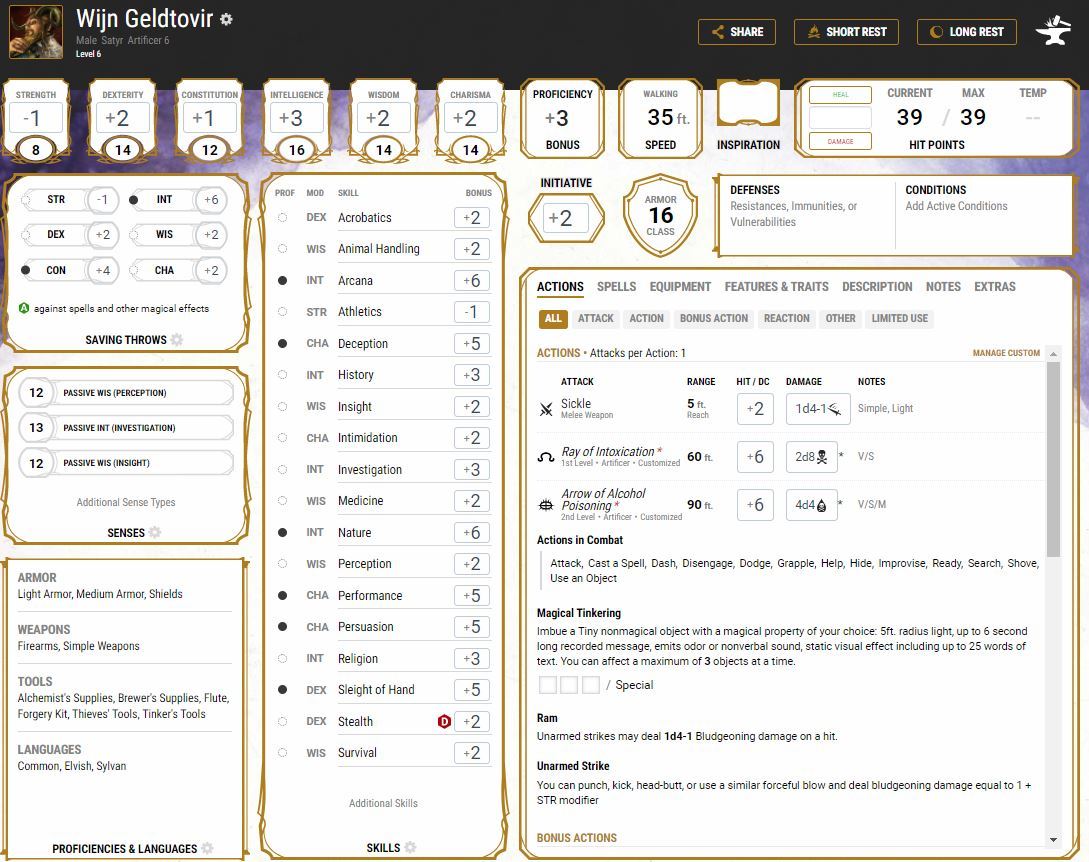
We've built a fun artificer with this class that's built around the idea of being a semi-famous wine maker from the Feywild. We use the Artificer class, with the Alchemist Specialist, to make potions, which -- for flavour -- we would play this as his ability to produce fantastic Fey wines which have the special powers that the Experimental Elixirs provide. Here's the link to his dndbeyond character sheet
If you want to steal this idea, here's how we went about this build:
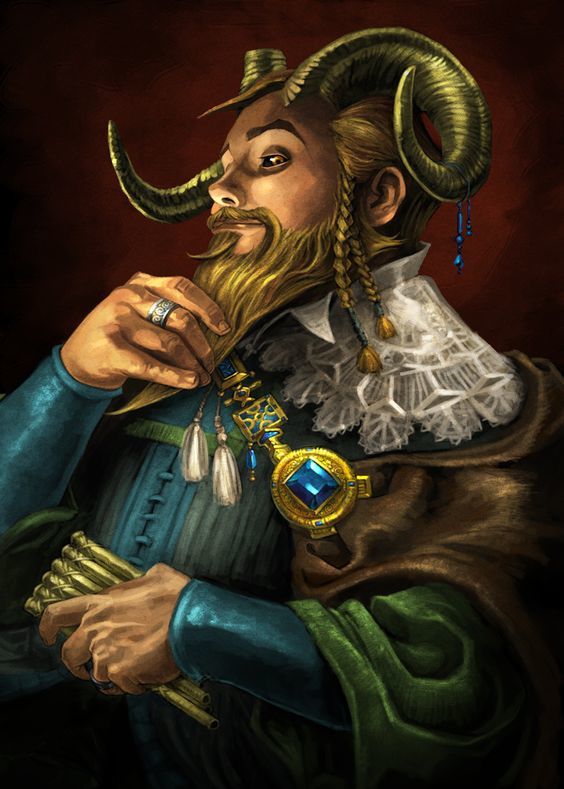
- We've built him at level 6. He just works better as a slightly more experienced character.
- For abilities, we did point buy: Str 8, Dex 13 (14 with racial bonus), Con 12, Int 14 (16 after ASI), Wis 14, Con 12 (14 with racial bonus)
- For Proficiencies: Nature (know your terroir), Arcana, and Brewer's Supply (we use this for wine making, along with his alchemist supplies.)
- For Artificer Infusion, we chose Enhanced Arcane Focus (to help his spells hit a bit better), and Alchemy Jug (because this fits the character so perfectly)
- He has used Replicate Magic Item to create a Perfume of Bewitching, which is part of his wine merchant salesman charms
- And he has Replicated the Armor of Gleaming, because he likes to look good.
- Also he's created a tankard of sobriety so he can "out drink" everyone at the bar.
- His Level 4 ASI is used to put 2 points into his Intelligence
- As for background, we chose a custom background we call "Wealthy Wine Seller", taking two skills, on tool and one language -- Decpetion, Sleight of Hand, Forgery Kit, and Elvish. These are all the things you need to seel cheap wine to elves at inflated prices. This and Prestidigitation to make the cheap sample stuff taste really, really good. We took the Background Feature from Failed Merchant called Supply Chain: "From your time as a merchant, you retain connections with wholesalers, suppliers, and other merchants and entrepreneurs. You can call upon these connections when looking for items or information." This gives him some fun hooks for any DM to work into the campaign's story. For characterisitics, we chose from the Charlatan Traits, Ideals, Bonds and Flaws.
We then went through his spell list and reflavoured the spells with new names that match his theme. Remeber, if you take this step, let you DM know, and provide them with a translation list of what the spells' actual names are. For example, Ray of Sickness has become Ray of Intoxication. Cure wounds becomes Healing Wine. Aid becomes Bolstering Wine.
We hope this helps inspire you to look for cool ideas that break the mould and make a truly memorable character.
(Credit: Satyr photo by Chris Kuhlmann. Article Header via WoTC)
]]>As schools go, Necromancy clearly has the worst PR team. Everyone hates on the wizards who want to bring things back from the dead -- until it's someone you love who's dead. We clearly have a collective distaste for messing with death. But enchanting on the other hand...
Enchanting sounds, well, sooo enchanting. The words "enchanted forest" bring to mind unicorns and talking bunny rabits. But in 5e D&D, that's not what it's about. The confusion is wide spread, and even the greatest DMs among us (looking at you Matt Mercer) still use the term enchanting to mean "putting magic into an item." (For the record: I love Pumat Sol and The Invulnerable Vagrant.)
But I submit to you, that in fact the School of Enchantment is the worst, meanest and creepiest of all.
It's about honing "your ability to magically entrance and beguile other people and monsters" (PHb). Even the word beguile doesn't sound so bad (they clearly have a better PR team than the necromancers). But when you look at the spells, there are a lot of them that are really dastardly.

Friends: This should be renamed "Frenemy" because after you cast, that person isn't going to be your friend anymore...
Vicious Mockery: Some of us went to schools where we felt the full force of how good the bullies were at this...
Charm Person: This gives you advantage on Charisma checks against the charmed, which can get really creepy, really fast...
Enthrall: This is the Daisy Duke of all spells. It's about wrapping the target around finger while your party sneaks past... Ok, maybe not that evil...
Suggestion: One of the most powerful things you can do in combat is disarm enemies. This gives you the power to tell them to throw their weapons into the river. Or as the text of the spell suggests: "For example, you might suggest that a knight give her warhorse to the first beggar she meets." That's such a major setback for just a second level spell. Ok, maybe there are some ways that could be cool...
Incite Greed: Clearly this one is evil. It prays on a deadly sin! Well, actually it just draws all the baddies towards you, possibly freeing up your friends. OK, maybe this one is bit heroic even...
Modify Memory: If I cast this on on you right now, I could tell you that this whole article has proven conclusively that Enchanters are Evil...or I could convince you that Enchanters are the coolest wizards of all time, and that you think it would be a great idea that you came to our school.
See nothing evil here at all.
(Credit: Header image by Vilenko Vujicevic, spiral from Wikimedia Commons)
]]>First: Treat this more like a boardgame night, and less like a big roleplay session.
Decide who is going to DM and who is going to have a character in the fight. Talk about the sort of character you want to test out in battle. It helps to think of this as a bit of a playtest. Regardless of whether the character wins or loses, the player should learn lots about what works well with the build and what doesn’t. This might be a useful game to play before you start a big campaign with a character, so you can decide if it’s really as good as you hoped.

Second: The DM needs to come up with a fight scene.
We use a dry erase battle map. It’s fast and easy to draw out an improvised fight setting. If you have something like Dungeon Craft tiles, or even some fancy 3D terrain from a company like Dwarven Forge, then by all means build whatever you like. This should be fun for the DM. If you ever get the feeling that building the scene is too hard, simplify. Just go back to drawing something on graph paper or a battle map. It takes very little for this to be a fun session. Don’t let prep ruin your good time.
Pick a suitably nasty monster or two. I recommend matching the character’s level with an equal CR value. If you add a couple more minions, consider also giving the player a sidekick. On average, the PC should probably win this. So the DM needs to play the baddies very strategically. The trick is to make it a close fight.
Third: Try out the sidekick rules.
Sidekicks are becoming a staple across many official D&D offerings including, Divine Contention, Dragon of Icespire Peak and Storm Lord's Wrath. There are UA rules for Sidekicks. And they are in the Essential Kit too.
Sidekicks can not only help in a fight, but can offer an opportunity for some witty banter. We play so that while the player decides what the sidekick does, the DM voices the sidekick, so they can have a funny relationship with the player. We have even picked up a couple fun sidekick supplements from the DMsGuild. I recommend Droop's Monster Manual of Sidekicks if you are looking for a more unusual creature to hangout with your PC. However you decide to do sidekicks, choose a level suitable for the fight, (probably best to err on the side of a little higher than lower). And then give them a healing potion in case of emergencies. If the PC goes down, the sidekick still has a chance to revive them.
Also, if you want to bring a bit more social interaction into the 1-on-1 fight, then you can allow short dialog as an additional free action on each turn, as well as a free verbal response from the opposing side — assuming they are the type of creature that talks.
Fourth: Vary the goals.
If you do fight night a lot, just fighting to the death gets a bit boring. Mix it up. Make a payload protection scenario. Or require the PC to destroy a McGuffin to close a portal. Or whatever. Whatever you build, keep the character in mind. Remember to design a scenario that allows the player to test out the character’s special features. Especially if you are playtesting anything that is homebrewed — you definitely want to get a sense if it is too overpowered, or clunky mechanically.
Five: Let The Wild Rumpus Begin
Grab your stat blocks and character sheets, drop some minis on the board, and roll initiative. We sometimes do a bit of a pre-roll chat about how the character got here and why. The set the scene with a bit of music. And have fun.
A word of warning: the higher the level of character you put into this situation, the longer this game will go. The last time we played a 20th Level fight, it took more than 4 hours before it ended.
(Credit: Header Image from the "I cast fist" meme)
]]>But one that begs for further examination is this: "When you cast a wizard spell as a ritual, you can use the spell’s normal casting time, rather than adding 10 minutes to it. Once you use this benefit, you can’t do so again until you finish a long rest."
So this would allow, if you picked a ritual with the casting time of 1-action, to cast a free spell as a ritual in combat. Neat! But let's have a look at which spells would be available and if any of these would be useful in a combat situation. There are only 9 wizard spells that fall into this niche category:

1. Comprehend Languages: Maybe.
No damage, no defense -- but information is powerful. You understand the literal meaning of any spoken language that you hear. Could be used to find out what the enemies are saying to each other.
2. Detect Magic: Unlikely.
No damage, no defense. You sense the presence of magic within 30 feet of you. Let's you know that your opponents sword is magical, just in time for it to cut through you.
3. Feign Death: Maybe
No damage, but a bit of defense. You touch a willing creature and put it into a cataleptic state that is indistinguishable from death. Playing possum is a risky strategy, but maybe against the right sort of dumb creature, maybe they will think you are dead too and leave your corpse for the buzzards. The good news is you'll be resistant to any damage you take while playing dead -- and that poison in your veins is no longer killing you. Bad news is that, well, you can't really defend yourself, or help your friends.
4. Floating Disk: Unlikely.
No damage, no defense. Pure creativity. This spell creates a circular, horizontal plane of force, 3 feet in diameter and 1 inch thick, that floats 3 feet above the ground in an unoccupied space of your choice that you can see within range. The disk remains for the duration, and can hold up to 500 pounds. Perhaps if the room was flooding and you needed to stay above the water. It has built in limitations that prevent you from treating it like a hoverboard. But as this is a first level spell, if you really needed it, you could probably afford just to cast it.
5. Gentle Repose: Unlikely.
No damage, and only a very particular defense. You touch a corpse or other remains. For the next 10 days, the target is protected from decay and can't become undead. Are you fighting a creature that can raise dead? If so, this is a good spell to be able to cast for free, especially if one of your party members goes down.
6. Telepathic Bond: Hell Yes.
No damage, no defense -- but infomation is powerful. You forge a telepathic link with 8 willing creatures. This is a pretty high-level spell (5th Level), so it's great that you can cast it without burning one of those precious slots. This is a great spell to get up in the first round of the fight so everyone in the party shares a private comlink. Silent information sharing and coordination of action is a powerful advantage.
7. Skywrite: Unlikely.
No damage, no defense -- but power to signal others. 10 words form in the sky. This is really only great if you have a bunch of re-enforcements waiting for your signal, and you don't want to waste a 2nd level slot to call them into the fight.
8. Unseen Servant: Maybe.
No damage, very little defense, but empowers your bonus actions. This spell creates an invisible, mindless, shapeless, Medium force that performs simple tasks at your command until the spell ends. The servant springs into existence in an unoccupied space on the ground within range. It has AC 10, 1 hit point, and a Strength of 2, and it can't attack. If it drops to 0 hit points, the spell ends. So you could put it between you and a bad guy and slow it down, just a little. Or you could be more creative: Once on each of your turns as a bonus action, you can mentally command the servant to move up to 15 feet and interact with an object. The servant can perform simple tasks that a human servant could do, such as fetching things, cleaning, mending, folding clothes, lighting fires, serving food, and pouring wine. Once you give the command, the servant performs the task to the best of its ability until it completes the task, then waits for your next command. Handy. For example, if you were trying to fight guards,_ and_ free prisoners, you could use your bonus action to have the servant get the keys, and the start unlocking cells. Anything that lets you do more on your bonus action -- for free -- isn't a bad thing to cast in combat.
9. Water Breathing: Maybe.
No damage, protection from drowning. This spell grants up to ten willing creatures you can see within range the ability to breathe underwater until the spell ends. This is certainly very situational, as not every combat involves the threat of drowning. But when water is involved -- this is a great spell to be able to get out for free without burning a 3rd level slot.
So if you are building an Order of Scribe wizard, when you hit 9th level, consider pickup Telepathic Bond -- it's the best 1-action bang for your ritual buck.
(Credits: Header image by Mateusz Mizak, concept artist and illustrator on Art Station. Article image by Marcel Mercado.)
]]>“Your wizard character’s most prized possession — your spellbook — might be an innocuous-looking volume whose covers show no hint of what’s inside. Or you might display some flair, as many wizards do, by carrying a spellbook of an unusual sort. If you don’t own such an item already, one of your goals might be to find a spellbook that sets you apart by its appearance or its means of manufacture.”
Some of the suggestions that come from Xanathar:
- A tome with pages that are thin sheets of metal, spells etched into them with acid
- Long straps of leather on which spells are written, wrapped around a staff for ease of transport
- A battered tome filled with pictographs that only you can understand
- Small stones inscribed with spells and kept in a cloth bag
- A scorched book, ravaged by dragon fire, with the script of your spells barely visible on its pages
- A tome full of black pages whose writing is visible only in dim light or darkness

How I've Learned To Ditch the Book
In an Ebberon camapign, I play a weird wizard. He's an old School of Invention build (which is no longer available on DndBeyond). He's an "arcanomech", a wizard in a suit of armor that he uses to cast his spells, which actually fits in with our game beautifully. He's similar but different from our Artificer Battlemaster, and our Bladesinger. Yes, we have a lot of wizardy types, but it is Eberron, so that's fine. They all have fighter like qualities, and we have a Warforged Gunslinger too.
Our party has an airship, and his talents make him the ship's chief engineer. He's also the cartographer. He has a magic Cartographer’s Case, like those found in Acquisition Incorporated. This is also his spellbook.
Within that case, he keeps not just maps, but also all of his many, many blueprints. His spells are all laid out like blueprints for systems of his arcanomech armor. We've also used the blueprint gimick to craft an new magical rifle for our crew's gunslinger. Once I started to roleplay the blueprints thing, they just started to come up in game play more and more, with the whole party referencing them. That's how his unusual spellbook has become a character in the game. It's fun and fits our setting -- which is an important part of character design.
5 Crazy Spellbook Ideas You Can Steal (Also the tag on the Header image)
So here are a few more ideas to get you thinking outside the book, but make sure you discuss with your DM how to make your zanny spellbook work within the setting and story.
Keep in mind, if you play a “Scribe”, your “spellbook” becomes your casting focus…which provides a cool opportunity to do some very unique casting. Also, the Order of the Scribe gets to summon a “Wizardly Quill”; this doesn’t have to be a quill if your spellbook isn’t a book. Each of the following describe what else it could be:
1. Arcane Kaleidoscope: a telescoping tube with a eye hole at one end, while the opposite end turns, tumbling the magical sands inside against the magic mirro to reveal the arcane patterns of the weave.
- Preparing Spells: Ss it is spun, the shapes an patterns reveal the arcane symmetry of each spell you wish to prepare. You take time gazing deep into and beyond the patterns.
- As a Casting Focus: When possible, the spell eminates from the end of the scope. This could be wand style, or for spells that target creatures, maybe you hold it up to your eye to cast at them.
- Adding New Spells: Adding spells to the Kaleidoscope is just as painstaking as writing in any book. You must proceed slowly, carefully pouring in new sacred sands in just the right combination, adjusting the mirrors, etc. For a Scribe, this only takes half as long as most wizards take to copy a spell. Gold cost for arcane sands, for a scribe, are half that of what a wizard would normally pay to copy a spell.
- The Wizardly Quill: Bag of multi-colored sand. Can be used to draw symbols on the ground, or flat surfaces. Sand can be sucked back into the bag if within 5’.
2. Mystic Rosary: A long string of pearls, each etched with an arcane glyph.
- Preparing Spells: You thumb each one as you work your hand along the string, the way a nun might move rosary beads during prayer.
- As a Casting Focus: The pearls could be wrapped in your hand, or around your neck. Perhaps they glow slightly as you cast. Flavor this as it fits your character.
- Adding new Spells: Your Arcane rosary could be worn first as a bracelet, but then as necklace as you add more and more spells to it, and gets longer and longer. For a Scribe, engraving the glyphs, drilling the holes and adding to the string of pearls only takes half as long as most wizards take to copy a spell. Gold cost for pearls, for a scribe, are half that of what a wizard would normally pay to copy a spell.
- The Wizardly Quill: Engraving tool. You can etch into very hard surfaces, like metal and stone. These markings can be dismissed with a wave of your engraving tool if within 5'.

3. A Conque Shell: a large shell that you can hold to your ear and hear the sound of the sea -- or in the Scribe's ear, the sound of the weave.
- Preparing Spells: You hold the shell to your ear, close your eyes, and listen to the arcane sounds of the sea of the weave crashing upon the shores of forgotten realities. As you listen closely your mind fills with the spells you wish to prepare.
- As a Casting Focus: For some spells you could blow into for the verbal component, other spells might make more sense if you held it to your ear to receive information.
- Adding Spell: To store spells in it the shell, you must send "magic winds" to the shores of the weave. This involves inhaling expensive insense, then slowly blow the magic words of the spell into the shell. For a Scribe, the gold cost of the insense is only half the normal spell cost, and the time it takes to blow the spells in is half the normal time it takes to copy a spell
- Wizardly quill: So where to we get the smoke? Maybe a pipe or other smoking apparatus. Maybe a tiny braiser, censet or thurible. You can also use this to create small smoke signals, that linger in the air. They would not only disappear with a wave of your apparatus, but likely also be dismissed by any breeze. This one definitely is out of the box, so be careful not to give it any more power than the original Wizardly Quill would have.
4. Lots of Little Artistic Knots: Call it what you will -- a Tapestry, a crochet blanket, a macrame belt, a knitted scarf -- anything that uses thread, string, yard, etc that you can keep adding to. Each of your little weaves, knots, and stitches becoming a symbol within the arcane pattern of the spell. Weaving the weave.
- Preparing Spells: You lay upon, or wrap yourself in your series of little arty knots, running your hands across the patterns, tracing the intricate nots, and percieving the arcane knowledge held within them.
- As a Casting Focus:
- Adding Spells: The Scribe buys their string, yarn, thread for half the gold cost a spell would normally cost, and spends half the normal time adding that material to their "spellbook" that a spell would normally take. If this were a scarf, a 20th level Scribe would have an enormous long wrap looped about them.
- Wizardly Quill: a tiny loom, a crochet hook, knitting needles. Can be used to mend clothing, or perhaps to stitch words into fabric, like a monogram. Anything stitched by the apparatus can be undone by the wave of the implement if within 5'.
5. Tattoos on Your Skin: While there are already some new UA rules for tattoos in the game, you could take this further with this subclass, etching
- Preparing Spells: You must disrobe and spend time studying the intricate patterns that criss-cross your body.
- As a Casting Focus: You are your spellbook. The good news is that should anyone remove your skin, according to the rules you can re-tattoo yourself with a short rest. Also keep in mind that the Scribe's spellbook gains a short of sentience. If your skin is the book, you might feel like it is crawling or bristling as it has a mind of its own.
- Adding Spells: As a scribe, you need tattoo ink worth half what normal spell would cost, and it takes half the noraml time to hammer it into your skin (and yes, it really, really hurts)
- Wizardly Quill: A tattooing needle on a stick (you tap this repeatedly on the skin to imbed the ink). You can also do non-magical tattoos for anyone, and the dismiss them with a wave of your tattooing stick within 5'.
These are in no way fully formed "spellbooks", merely starting points for you and your DM to make a cool and unusual scribe for your collaborative storytelling.
(Credit: Header Image by Akreon on Deviant Art)
]]>And while he looks like a knight, or perhaps a paladin in his heavy armor, he’s none of these things. Welcome to another edition of Steal This Character where we show you how to build against tropes. This time we are building a character that is going to look and behave a lot like a paladin in game, but actually uses the Ranger class.
Yes, gasp , we are using the oft-maligned Ranger class. It’s not all bad, and we have a couple little table rules that help. You can find this Character’s Sheet here. So let’s dive into our Heavy Metal Holy Ranger using the DndBeyond Character builder:
1. Choose Variant Human for the Heavily Armored Feat
This is how we put the heavy in Heavy Metal Holy Ranger. The feat also gives a plus 1 bump to Strength, which is great as this build is going to be a Strength Ranger, or as we like to call them, a StRanger. Choose Infernal as your extra language.
2. Take 7 Levels of Ranger
This is about the point where things get fun for rangers, and where this character would be ready to descend into the Hells. For proficiencies: Athletics, Perception and Survival. Favored enemies: Fiends. This guy is a demon/devil hunter. And for the other favored enemy, we chose elves because we see him possible fighting Drow for reason we can’t explain. It also means we can choose Underdark and swamp as favoured terrain. Why swamp? Because “Lower Planes” isn’t an option.
Side note about Rangers: Let’s just say, favored terrain isn’t as open to creativity as it should be. I’ve often thought, and this is my table rule, that the best thing to do is just say that the Natural Explorer feature just works everywhere. It’s a small buff, but would really make Rangers more awesome more of the time. It also means choosing favoured terrain is more of a storytelling element than anything. But talk with your DM about this. Another option would be to allow players to add terrain like lower planes, or urban or wherever your game finds itsself located. The other really simple table rule to help buff Rangers without doing lots of crazy new features: let them add their proficiency bonus to damage they do to favored enemies. But again, have a discussion with your DM.
For Fighting Style: choose Defense. This gives the full-plate an additional +1. By the time we are done, your AC will be 22.
For Ranger Archetype, we went with Monster Slayer, which let’s you spend an action to learn a creature’s immunities, resistances and vulnerabilities. It also grants Slayer’s Prey, which as a bonus action let’s you designate one creaute as your prey, and grants an extra 1d6 the first time you hit it each turn. This is all helpful when fighting extra planar fiends. Then at 7th level we gain Supernatural Defense, which stacks with Slayer’s Prey (and “Supernatural” anything sounds cool for our Holy Ranger). It gives an extra 1d6 to make saves and ability checks to escape grapples that come from the target of your Slayer’s Prey.
For the 4th Level ASI, take a point in Strength and another in Constitution.
For the 6th Level Favored Enemy: take Undercommon and Undead.
We will come back to spells at the end.
3. Ability Score Point Buy
Strength: set to 15, and with bonuses it should come to 18. Beefy!
Dexterity: _10. Doesn’t help with heavy armor, so forget about it.
_Constitution: 13, plus bonus will take it to 14. By level 7, you should have 60hp. With an AC of 22, that should let you tank a bit.
Intelligence: 8. Dump stat. Deal with the fact that your investigation checks will suck.
Wisdom: 15, with bonuses will come to 16. This is your casting ability, and what will make this knight really stand out among Paladins.
_Charisma _10. This is the other thing that will stand out among Paladins, this characters lack of natural charm.
4. Folk Hero Background
The reverend has come a long way from his humble origins. He has animal handling (loves dogs, and is a prize winning breeder). Also take Religion because, well, Holy Ranger.
5. Big Equipment
This is a build that needs Plate armor. Also a +1 Shield. This will take your AC to 22. Not bad for the addition of just one simple Uncommon magic item.
And maybe for a bit of flavor, something like a Moontouched Longsword, so you can hack and slash in the dark. This is a common magic item, which simply does what a torch does, but also lets you hit things like with a sword. This will give you 1d8+1d6+4 (average 13) against your Slayer’s Prey target’s
6. Jump Back to Spells in Class
The spell list is pretty simple for Rangers, but we want to give him some of the similar abilities a Paladin has. Firstly, healing: take Cure Wounds and Detect Poison and Disease. Also take Healing Spirit.
Then to make up for lack of Divine Smite, take Zephyr Strike. This, which casts as a bonus action, makes it so you don’t provoke opportunity attacks, can move an extra 30’, and get into position on your quarry. Then once within the 1 minute concentration duration of this spell, you gain advantage on one attack, and deal an extra 1d8 damage on that hit. So this combines together with your Slayer’s Prey to do 2d8+1d6+4 on an attack with advantage. Also you still get a second attack, but it will just be 1d8+4.
And finish off with Pass Without Trace. Plate armor may have disadvantage on Stealth checks, but a +10 will help.
(Credit: Header Image, artist unknown)
]]>So here’s the idea: can we substitute Duskcrusher for the Sunsword?
Powers and Ability Comparison:
The first big difference is that the Sunsword is sentient. But that’s easy enough to give to Duskcrusher too. After that, the Sunsword is essentially just a Sunblade.
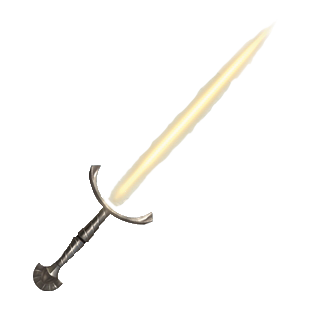
Sunblade powers:
- You gain a +2 bonus to attack and damage rolls made with this weapon, which deals radiant damage instead of slashing damage. When you hit an undead with it, that target takes an extra 1d8 radiant damage.
- The sword's luminous blade emits bright light in a 15-foot radius and dim light for an additional 15 feet. The light is sunlight. While the blade persists, you can use an action to expand or reduce its radius of bright and dim light by 5 feet each, to a maximum of 30 feet each or a minimum of 10 feet each.
Duskcrusher powers:

- While the radiant head is active, you gain a +2 bonus to attack and damage rolls made with this magic weapon, and attacks with the weapon deal radiant damage instead of bludgeoning damage. An undead creature hit by the weapon takes an extra 1d8 radiant damage. (This is pretty much the same.)
- The warhammer’s radiant head emits bright light in a 15-foot radius and dim light for an additional 15 feet. The light is sunlight. You can use an action to make the radiant head disappear. (The only difference is the sunblade’s light can be extended. This is something the Duskcrusher can do only with the use of the following feature)
- While you are holding Duskcrusher and its radiant head is active, you can use an action to cast the sunbeam spell (save DC 15) from the weapon, and this action can’t be used again until the next dawn. (This expands the sun light to 30’ for one minute. During that duration, you can shoot 60’ beams of sun light that all creature in must make Con saves or take 6d8 radiant damage. Undead have disadvantage. Failed saves also result in blindness for one round.)
Making it Work in The Story
Orginally Strahd's borther owned the Sunsword, back when it had a crystal blade. So, why did Sergei von Zarovich have a warhammer? Why does anyone? Perhaps it’s not the most gothic of items, but perhaps it once was an item of great beauty. Just as the Sunsword once had a crystal blade, so too did the warhammer. It was an art piece perhaps, one that symbolized the fragility of power when used heavy-handedly. What matters is that it’s sentience has always bothered Strahd, and that following Sergei’s death, he employs the wizard Khazan to destroy it. But only the crystal was destroyed, and the rest of the weapon was rescued by the wizard’s apprentice. The apprentice is found in mutilated in the Svalich woods, possibly torn apart by wolves trying to flee Barovia. The Duskcrusher then shows up in game wherever the party might find the Sunsword.
Tell Me Again Why You Would Want To Remix The Story
These two magic items are so similar in so many ways, but are from two different generations of the game. Much like Jack and I are as players. That’s what makes this game so great: Rip, Mix, Burn. It is yours to pull apart and put back together. And it’s yours to make beautiful for your players. If you play with Critters who love the Wildemount stuff, but have agreed to give old CoS a try, a touch like this might delight them a lot more than just the story as written. Or maybe just for your own enjoyment as a DM to know how to make substitutions of similar items, or creatures, or traps, or whatever that keeps the game fresh. Dig back into old source materials or reach forward into new ones — it can all be made to work together in exciting new ways.
]]>One of the items that came up was the Spell Bottle. It's a cool device for storing lower level spells and then releasing them. I hadn't though much more about it other than to muse that it would be cool to stuff a Lightning Bolt in there and label it "lightning in a bottle".
But Jack caught me off guard with what seems to be a contradiction within the rules of the item. The rules say that the bottle can store one spell up to 5th level at a time. And there’s good reason for that when you think of the destructive power higher level spells could deliver simply by uncorking the bottle.
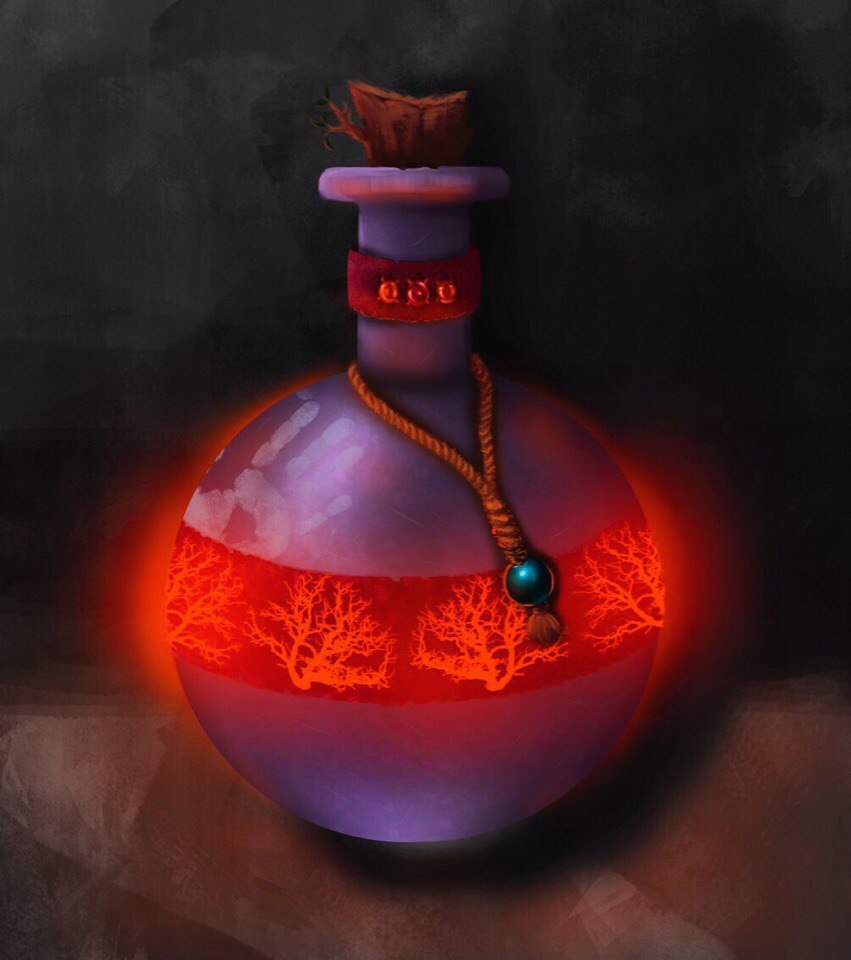
But the rules also state: "If you’re holding the empty bottle when you see a creature casting a spell within 60 feet of you, you can open the bottle as a reaction in an attempt to interrupt the spell. If the creature is casting a spell of 3rd level or lower, the spell has no effect, and it is stored in the bottle. If it is casting a spell of 4th level or higher, make an Intelligence check. The DC equals 10 + the spell’s level. On a success, the spell has no effect, and it is stored in the bottle.”
It’s that last line, which doesn’t say “4th or 5th level” like it should, but rather opens the imagination to the bottle storing any level spell, so long as it’s not the owner of the bottle who casts it. I’m not sure that's what was intended. But for the sake of the next question Jack stumped me with, let’s roll with it for a minute.
Here’s the puzzle: if you interrupt a Wizard casting the Wish spell, and you succeed on beating the DC 19 Intelligence check, then you capture the Wish in the bottle (and who doesn’t love the old wish-in-a-bottle trope?), but then whose wish does it become? Does it continue to be the original caster's wish, and should it ever be released that spell will run to its conclusion? Or does it become a new wish spell, that of the person who uncorks the bottle?
I’m a dreamer, so I’m going to go with the second option — assuming the person who has the bottle knows that it has a wish in it, and knows what to do with it, and the consequences of trying to do too much with it.
However, as a DM, I wouldn’t let the bottle store any spell above 5th level…but I might let it interrupt a higher level spell if the holder successfully made the DC check. Perhaps it siphons off just enough of the magic power to cause the spell to fizzle out. It would be like having an ever-ready Counterspell.
But maybe even that is wishful thinking.
(Credit: Article image by LaPesteAParis Creative Commons )
]]>First, let’s be clear on why you want to hide. Two words: unseen attacker. "When a creature can’t see you, you have advantage on attack rolls against it." -- PHB 194, Unseen Attackers & Targets.
So what does it take to hide? Let’s take a look:
1. Find Cover. Hide is Not Invisibility.
You can’t just hide in plain sight (that’s a Ranger thing, and a sad story for another day). You need to find some cover to hide behind. How much cover? The DMG provides some guidelines, in Vision and Light (pg 183 if you've got paper), which simplified means that you need to be heavily obscured, which translates to the equivalent of at least 3/4 cover. Other circumstances might give away your location, making you “seen”, so not every place you try to hide is going to work. But keep trying. Even darkness will count as being heavily obscured (unless whatever you are hiding from has darkvision).
2. Stealth vs Passive Perception
All you have to do, is move your character behind 3/4 cover and declare that you would like to take the “hide” action. The DM will then ask you to make a Dexterity (Stealth) check, which he will way against the enemy’s passive perception. If your roll beats that number, you are officially hidden. This now gives the enemy, if somehow informed where to shoot even though they’ve lost track of you, disadvantage to hit, plus you gain the +5 to AC from the 3/4 cover. Yes, that’s like super armor. More likely though, they won’t even know you are there, so they’ll attack the tanks in your party instead. You can also hide in any area that is completely dark, and while they will have disadvantage to hit you, you’d gain no AC boost.
If you take the Skulker Feat as an ASI, then it reduces the requirement to just lightly obscured, which includes dim light and 1/2 cover. This should make it even easier to hide.
3. Make Your Unseen Attack
At any rate, once hidden, on you next turn you shoot. With advantage. And that means if you are a rogue, you get to add your sneak attack damage. Fun stuff.
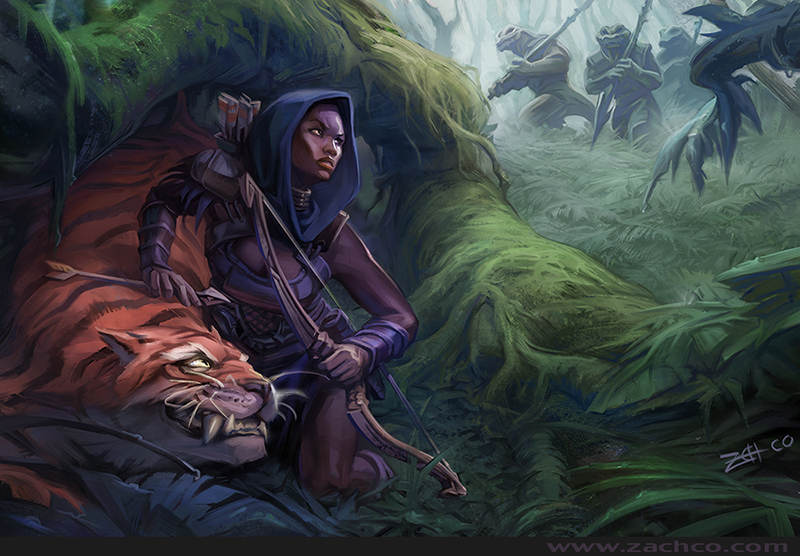
But then you are no longer hidden. And no, no you cannot simply re-hide in the same place. That leads to a really abusive use of hiding. Once a hidden creature makes an unseen attack (unless the have the Skulker feat and miss with the attack, in which case you remain hidden), then they are seen and need a new hiding spot. So the PC must move to a new position, and once again try to use their stealth to drop out of sight from their target.
The rhythm of the Rogue: Shoot, move, hide. Shoot, move, hide. Put that Cunning Action to work for you and hide every round. I don’t care if that is back and forth between two spots of darkness, or two different thickets of bushes, but that is what has to happen. This prevents hiding from being a non-magical version of invisibility. But talk with your DM about this. They may be more cool with you re-hiding in the same spot.
4. Get Hidden Before the Fight Starts.
You also need to learn to hide so that your party gets a surprise attack round as often as possible against as many targets as possible. This is too good of a rule to miss out on. The way it works, before you roll initiative, the DM calculates if anyone who is hiding and trying to make a surprise attack is stealthier than the passive perception of their quarry. Anyone whose Passive Perception is below the Stealth roll of an ambusher misses their turn in the first round. All it takes is just one successful stealth check. JUST ONE!
“The DM determines who might be surprised. If neither side tries to be stealthy, they automatically notice each other. Otherwise, the DM compares the Dexterity (Stealth) checks of anyone hiding with the passive Wisdom (Perception) score of each creature on the opposing side. Any character or monster that doesn't notice a threat is surprised at the start of the encounter.” - PHB, The Order of Combat
If you're surprised, you can't move or take an action on your first turn of the combat, and you can't take a reaction until that turn ends. A member of a group can be surprised even if the other members aren't.
This is a big boon to the party. Even if just you, the stealthiest character in your party, hides before a fight and then surprises three out of the five goblins that approach, then those three goblins all miss their first turns, even if your party’s clanky paladin surprised no one.
Learn to take the hide action as often as you can, and take your game play to the next level.
(Credits: Header image "Archer" by Nicole Cardiff "thegryph" on DeviantArt. Article image "Hiding in the Woods" by Zacho)
]]>
I play him in a homebrew campaign where he has served as a spy for the Royal Court for many decades. He's still a Firbolg in that he wants to protect the forest, but he's done so by gaining the trust of the king and who has protected a large section for him by Royal decree. He's a part of an organization of scouts and rangers known as The Royal Woodsman, which allowed him to patrol the woods and legitimately combat poaching and logging. And he thought life was pretty great...until a recent coup has undone a lifetime of hard work. He and his party of Royal loyalists, now outlaws, are crisscrossing the kingdom, pulling together allies in an effort to restore the rightful family to the throne...
What makes him so much fun is that he's easily the biggest character on the table: 8' tall, wearing a leather duster jacket and a slouch hat, and carrying a big, heavy crossbow -- yet, he's the stealiest, most easily hidden character of the party. I think of him like a sasquatch or Big Foot: people sometimes get a glimpse of him, but usually only just as he's shooting them with a 1d10+2d6+4 crossbow bolt. As for ammunition, he prefers an in-game brand known as King's Quarrels. They do the same damage as all the other crossbow bolts in the game, but he insists on using his brand if at all possible. I really enjoy taking the heavy crossbow as a rare change of flavor from the longbow, which nearly every rogue realies on. Longbows are definitely much easier to use, but easier doesn't always mean more fun. Sure, some rogues might go for hand crossbows, but how many are packing heavies? It's rare, and rare isn't boring.
So here's the build breakdown using DndBeyond.com (click here for the character sheet). First thing to note: he's a multiclass with one level in fighter. This is important to get him proficiency in his beloved heavy crossbow. At some point, he'll probably take another level of fighter to gain the Action Surge feature, which will serve the party well given his skirmisher role and Hidden Step ability.
1. Race:
Choose firbolg. As a scout, you'll want to take advantage of his Hidden Step feature, as well as his special ability to shrink down and disguise himself. Also, remember that Speech of Beast and Leaf doesn't let you have conversations with animals and plants, but instead let's roll with advantage to influence them. So Forrester will do things like ask trees to move branches to improve his cover from half to three-quarters, or ask birds to show him the way to the nearby enemy camp. Don't try to chat with them, just ask them to do things-- and then roll persuasion with advantage.
2. Class:
Take 4 levels of Rogue and 1 level of Fighter. For the Fighter's fighting style, coose archery to get your +2 bonus to attack with range weapons. Also, Second Wind is nice to have when you are a glass connon like this build.
For the Rogue levels, take expertise in Stealth and Deception (for when you use your innate Disguise Self). Choose the Scout Archetype (available in from Xanathar's Guide to Everything). The Skirmisher ability is great for keeping your distance from the fight, which is key to keeping this character alive. Keep moving, hide behind cover, make an unseen attack with advantage. Repeat.
For your 4th level ASI, chose skulker. First, this makes it much easier to hide, and if you make a sneak attack from hiding and miss, then you don't have to move to re-hide, as you just stay hidden and can try again on your next turn. Shoot, move, hide. Shoot, move, hide. That's this character's job in a fight. Done well, it is a powerful support.
3. Ability Scores
I'm not going to lie: Forrester doesn't have the best scores. But that's ok. He still does great with these. Using Point Buy:
- Strength 9 (racial bonus will take that to 10, which given his powerful build will still let himcarry as much as a human with Str 20)
- Dexterity 15 (This might not seem so great for a Dex fighter, but with his heavy crossbow proficiency, plus the Archery fighting style, this will still give him +7 to hit. The DM has also given him some special Bracers of Archery that are for crossbow use, so that helps make up a couple more points of damage he's lacking from having a lowish Dex)
- Constituition 12 (never let this be your dump stat)
- Intelligence 10
- Wisdom 10 (with racial bonus this comes up to 12)
- Charisma 15
At level 8 in rogue, he'll use his ASI to boost both Dex and Cha by one, which will give him an extra +1 with both abilities.
4. Description
Make a Custom Background called Royal Woodsman, based on Soldier: "His rank comes from his service within the Royal Woodsman, a title he still holds. The empty tool slot below is filled in on the character sheet with gardening tools, a hobby (and cover identity) he has enjoyed for many years around the Royal household."
Take two Skill Proficiencies: Perception and Animal Handling.
Take two Tool Profciencies: Vehicle (Land) and a custom artisan tools, Gardening Tools. Yep, he loves to garden. And if you think that wouldn't come up, think again. I've used it twice to befriend NPCs.
Chose the Background Feature of Soldier, and the Characteristics from Folk Hero.
5. Equipment
He started out simple. Leather armor, heavy crossbow, some ammunition, some gardening tools, some theives tools, a dagger. He's picked up a few adventuring tools along the way (torches, potions of healing and such)
That's it. Please, go ahead, steal this character, then remix him to your hearts content. Make yourself one of the rarest rogues in the world.
]]>But that’s possibly also the reason you shouldn’t take it. If there are five or six players at the table, and no one has good investigation, then at certain important points of the adventure — like exploration — you suck. We talk about the importance of exploration in our episode, Playing All Three Pillars. But basically, Investigation is all about clues:
“When you look around for clues and make deductions based on those clues, you make an Intelligence (Investigation) check. You might deduce the location of a hidden object, discern from the appearance of a wound what kind of weapon dealt it, or determine the weakest point in a tunnel that could cause it to collapse. Poring through ancient scrolls in search of a hidden fragment of knowledge might also call for an Intelligence (Investigation) check.” - PHB, Investigation
In order to find an object with Investigation, the object needs to have some findable clues (DM this is your job to provide). You can use Investigation to find out the Why of something that everyone can see (Perception). For example, if you enter a room filled with broken furniture, investigation is like the CSI unit figuring out how the fight went down that broke the furniture, and what sort of creatures might have been involved. It provides insight and hints about the campaign’s story, just as Insight provides clues into a character’s motives. Investigation checks can give you clues that you can follow-up on (a chance for the DM to drop more story hooks).

Remember, you don’t need proficiency with a skill to make an attempt — but it certainly helps. Often Investigation is left to Wizards, as they have the highest Intelligence scores. But I would argue that maybe your next rogue should lean into both their Intelligence ability and their Investigation skills, and here’s why: traps and secret doors. It is often frustrating for the party (and possibly the DM) at how you can never find a way to disarm a trap or a open secret doors.
That’s right: detecting a secret door is a perception check (although investigation might give you clues that it exists, like finding worn floorboards near a bookcase). But once a secret door is detected, Investigation checks are made to figure out how to open it (perhaps the book without any dust on it gets pulled out a bit to release the catch). This isn’t table rules, this is straight up DMG, Dungeon Features:
"Opening a Secret Door. Once a secret door is detected, a successful Intelligence (Investigation) check might be required to determine how to open it if the opening mechanism isn’t obvious. Set the DC according to the difficulty guidelines in chapter 8."
The same goes for disarming traps: The DMG suggests calling for an Investigation check to figure out the mechanism for the trap before performing a Dexterity check with thieves tools to deactivate or sabotage it.
If you want to play investigation cool, think Sherlock Holmes. Think about how your character has the powers to deduce situations. Think CSI, and how your character can reconstruct a crime scene. Put investigation into your roleplay, and you will have lots of opportunities to help the DM move the story forward.
Then, just accept that you are going to get surprised in combat and place yourself somewhere in the middle of the marching order. You’ll be fine. Go #TeamInvest!
(Credit: Header image by DevBurmak, a freelance artist on Deviant Art who is open for commisions!)
]]>
Clearly there is a desire for exploration. But it’s a term that means a lot of different things to different people. Some see it as finding out information about a world — or your villain’s plot. Others like the gritty realism of making survival checks to cross the wilderness to some undiscovered country. For a few brave DMs, it’s about creating further mysteries to be solved, and opening opportunities for new character arcs to evolve. But for some DMs, that’s just too much extra work, and they would prefer toskip ahead with a hand wave that fast forwards the adventure to the next important part of their story.
For some DMs, exploration is calculated travel time, with each hex crossed on the map heightening conflict by draining PCs of resources and hit points. And while I like the principle behind that, I caution against achieving this outcome through the use of “random encounters.”
Don’t be that lazy as a DM. You owe it to your campaign to do better than roll on an encounter table to see what the party bumps into, or to simply wave your hand to skip all that stuff. Time at the table is precious. So it’s up to you to make sure every scene, every NPC, every detail moves the story forward, towards the party’s ultimate goal — or toward your villain’s. That’s how you keep exploration from every being boring or a waste of time.
Use every exploration scene, be it on the road or on location, to paint a more clear picture for the players as to world they live in and invest them in the stakes of the game. Allow each exploration encounter to hint (not too subtly) at the unseen forces at work in your world — or perhaps the monster we all carry inside us. Use these not-so-random exploration encounters to touch on the PC’s faults, using the time as a way for the players to become not just lost physically, but morally. Exploring each other’s character arcs is an crucial part to any campaign.
Or if your party is less into that, use not-so-random encounters to introduce the very specific creatures of the realm that foreshadow larger more dangerous fights to come — but don’t always make it about the fight. Let it be about insight and investigation, about perception and nature. Let the party try to figure out what’s going on, and give them a chance to discover clues sooner. Sometimes the greatest treasure is foreknowledge.
(Credit: header artwork by Marie Magny)
]]>Also be sure to listen to our walk-through of this character in the podcast episode, Two Generations Talking D&D
The following steps will help you through the Dndbeyond.com character builder. If you don’t use this tool, ask yourself why not? We love it.
1. Choose a race that gets a Strength bonus.
We chose Goliath. With +2 to Str and proficiency with Athletics, it gave us what we wanted for our “fitness coach” character idea
2. Take the Warlock class, and choose Otherworldly patron.
We picked Celestial, and more specifically found the Empyrean to be just the sort of patron that someone obsessed with physical fitness would have. Take Nature (to find ingredients for supplements), and intimidation (because yelling at someone to get one more rep really does work)
For Invocations: Fiendish Vigor (We call it Heavenly Vigor), Armor of Shadows (we call it Glitter Armor), Gift of the Ever-Living Ones (let’s you regain max amount of HP from healing if familiar is near)
We also chose Pact of Chain so he could have a small bulldog familiar. He can cast spells through his familiar, so this makes it possible for the dog to go over and lick a party member to cast Cure Wounds, restoring maximum value or even Revivify on them (his dog collar is studded with requisite value of diamonds).
Choose some spells. This may vary depending what level you start out at, but get the basics: Booming Blade, Prestidigitation, Cure Wounds, Armor of Agathys, Expeditious Advance (retreat is for puny wizards). Check out the character sheet link above for our full spell list.
3. Point Buy abilities.
This gives the greatest customization while still remaining fair to the other players at the table. Str 15, Dex 14, Con 15, Int 8, Wis 8, Cha 10. Yes, that’s a low score for the casting ability, but most of the spells he’ll be casting are personal buffs rather than attacks. He’ll use his club for doing damage.
That will bring his stats to: Str 17, Dex 14, Con 16, Int 8, Wis 8, Cha 10
At 4th level, use your ASI to take Athlete, boosting Str to 18, and giving the character more "fitness" thematic flavor.
At 8th level, take War Caster feat to support Sculptor of Flesh Invocation, allowing you to swell into a Giant Ape sized fighter (add a giant ape stat block to your extras). For thematic purposes, this is the only thing he really ever turns into. We don’t imagine him exactly polymorphing into an ape, but rather hulking out into some ape-like huge form that still looks a bit like Hightower. Strength goes to 23, two fist attacks are at +9 each, and do 3d10+6 damage. Also your range attacks with rocks become super good too. Only in the most dire of situations might he consider becoming something smaller, and even then it would bring him great shame.
4. Custom Background: Bodybuilder.
Take acrobatics and survival. Gain the tool proficiency with herbalism kit (for making health supplements), and gain the language of Celestial (so he can talk with the boss). Borrow the background feature from Gladiator called “By Popular Demand”, but instead of the line that says “combat for entertainment”, it’s “feats of strength for entertainment”. Any chance to flex for and audience for fun (or money), he does. And then use the Guild Artisan Characteristics to reflect how much he loves to talk about health and fitness routines.
5. Keep equipment simple.
We chose a great club and a short sword. Add in a healer’s kit, a herbalism kit, and you’re done.
(Credit: Header image by @Tartan_Kiwi, who is open for commisions!)
]]>My sister would tell, me years later, how impossible it was to hang out with me and my friends back then as we would always just start talking about D&D, and to her it was a deeply geeky cryptic code that she could never parse. It perplexed her, and she felt like she was missing out on something really fun because we were always laughing so much. And then as the years went by, it got even worse as we added more and more rpg and tabletop combat systems to our repertoire.
Then it all stopped. At least for me. Life, college, different friends, a different part of the world. And for a long time, I had no one to talk D&D with. I completely missed 3rd and 4th edition. I’d think about old adventures from time to time. And as I write this, it occurs to me that I’ve never stopped dreaming up fantasy worlds, nor the characters that inhabit them. I was just missing someone with whom I could once again start talking about it.
When my son turned 10, I started to host some D&D parties for him and his friends. The timing was good, as 5th edition had been out for about 6 months. There were lots of things in it that were new to me, but lots that was a familiar and comfortable as my favourite pair of old blue jeans. I made up their characters, and helped them through the basics of how to play (even if I still didn’t have all the nuances of the new system figured out yet.
It was a modest start, but I loved how much Jack seemed to enjoy it. We soon began to play it on summer holidays, meeting up with my own childhood rpg friends, who also now have rpg kids, and playing marathon sessions. I had found my way back into one of the greatest pleasures in life.
Jack then went on to find a group at school that started to play. Kids today no longer have to hide in basements and keep it a secret that they play -- lest the cool kids find out and bully them for it. Back in the day, you didn’t tell girls that you played D&D if you wanted any chance of dating. Now, Jack plays in one campaign where at a table of six players, he’s the only boy. I envy how good he has it. There has never been a better time to play D&D.
Sure enough, my son and I started to exchange that same deeply geeky cryptic code of D&D. All the time: in the car, while out hiking, while doing the dishes. My wife looks at us the same perplexed look that my sister used to all those years ago.
But here’s the thing: It’s not me sitting atop the monkey bars holding court. My old brain, as hard as it tries, can’t keep up with Jack’s. He’s the one with the encyclopedic knowledge of 5e.
One of the misconceptions I get when I tell people I’m doing a D&D podcast with my son is that I’m in the teacher role. I don’t feel that way at all. This podcast is a partnership. Sure, I might bring some old school wisdom to share at the table, but I also come to learn -- and laugh.
I hope you will too.
Check out our first episode, where we, well, talk about D&D...including a controvesial Strength-based Warlock build: The Starlock!
]]>